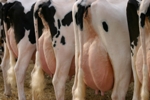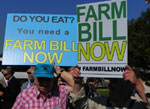 In a situation reminiscent of last year, Congress returns to Washington this week with a limited amount of time to deal with the farm bill before several current programs expire.
In a situation reminiscent of last year, Congress returns to Washington this week with a limited amount of time to deal with the farm bill before several current programs expire.
In 2012, the election season limited the amount of time Congress could deal with a new farm bill, and ultimately, a new measure wasn’t passed. This year, in addition to farm policy, lawmakers must also deal with the expiration of the fiscal year funding authority after Sept. 30th, extend the debt ceiling, and consider authorizing military action in Syria. These contentious items are expected to dominate action on Capitol Hill in September.
For those in agriculture hoping for action on the farm bill, the focus remains on the House, which passed a flawed, farm-programs-only measure in July as part of a two-step process. House leaders have talked recently in generalities about taking up the nutrition-policy-only title soon after reconvening on Monday. If that nutrition bill passes, the House presumably would name agriculture committee conferees to meet and hash out a final farm bill with counterparts from the Senate.
But the nutrition bill the House will consider is expected to cut $40 billion from food stamps, ten times the size of the reduction contained in the Senate farm bill. The extent of that reduction will not attract much, if any, support from House Democrats, and it will be a difficult figure to reconcile with the Senate’s version, once both measures reach the House-Senate conference committee process. If the two congressional chambers fail to agree on a farm bill that can be signed by President Obama by September 30, yet another extension of current programs is one potential outcome.
Another is that those programs that expire at the end of this month – including the Milk Income Loss Contract (MILC) program – will be left in limbo until a decision is made about whether to try for a new bill, or extend the current one – as was the case in the fall of 2012. Given where dairy prices are, no MILC payments are expected in the remaining four months of this year.
Other farm programs, including the dairy product price support program, are authorized through December 31. If either a new farm bill isn’t in place by then, or current programs aren’t extended yet again, the provisions of the Agricultural Acts of 1938 and 1949 will take effect, potentially resulting in much higher price support levels for a variety of commodities, including milk.
Dairy farmers should continue to urge lawmakers to pass a farm bill, including the dairy policy reforms endorsed by the Senate in June. The House gutted those reforms in July by approving margin insurance without a stabilization program to keep supplies from building up and prices from plummeting. Farmers can use NMPF’s Dairy GREAT system to send an email.

 USDA’s National Agricultural Statistics Service (NASS) said last month that with the start of a new fiscal year on October 1, it will resume the quarterly milk production producer surveys it suspended earlier this year due to budget cuts.
USDA’s National Agricultural Statistics Service (NASS) said last month that with the start of a new fiscal year on October 1, it will resume the quarterly milk production producer surveys it suspended earlier this year due to budget cuts. NMPF continues to create awareness of dairy products – and the REAL Seal itself – through its new social media campaign connecting a new generation of consumers with products that use the Seal.
NMPF continues to create awareness of dairy products – and the REAL Seal itself – through its new social media campaign connecting a new generation of consumers with products that use the Seal. Congress left Washington August 1st for a five-week recess, with the fate of the 2013 farm bill still very much up in the air. Prior to leaving town, House Republican leaders negotiated a farm bill nutrition title that raises to $40 billion the level of cuts to food stamp programs. This food stamp-only measure is likely to be voted on once the House returns Sept. 9.
Congress left Washington August 1st for a five-week recess, with the fate of the 2013 farm bill still very much up in the air. Prior to leaving town, House Republican leaders negotiated a farm bill nutrition title that raises to $40 billion the level of cuts to food stamp programs. This food stamp-only measure is likely to be voted on once the House returns Sept. 9. After a promising start in 2013, efforts to reform America’s immigration policies have stalled in the House of Representatives, and frustration is beginning to spread in the organizations that have worked on the issue, from agriculture, to the business community, to religious groups.
After a promising start in 2013, efforts to reform America’s immigration policies have stalled in the House of Representatives, and frustration is beginning to spread in the organizations that have worked on the issue, from agriculture, to the business community, to religious groups. NMPF’s campaign to reposition the REAL® Seal program continued in July, with a big push to garner visibility on Facebook, where in less than two months, the
NMPF’s campaign to reposition the REAL® Seal program continued in July, with a big push to garner visibility on Facebook, where in less than two months, the 



